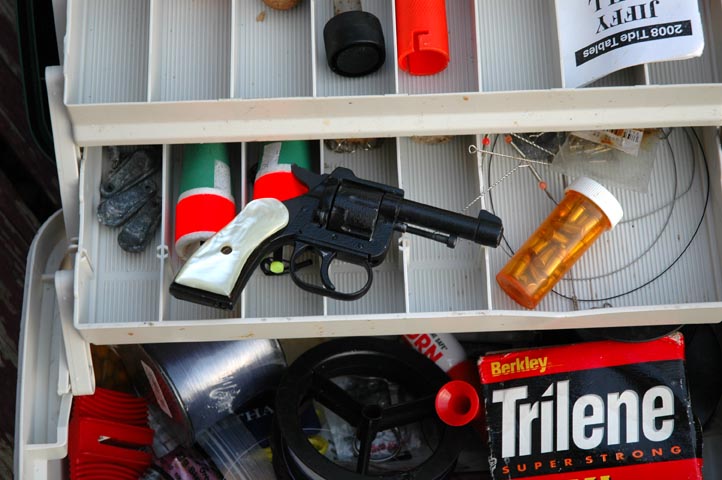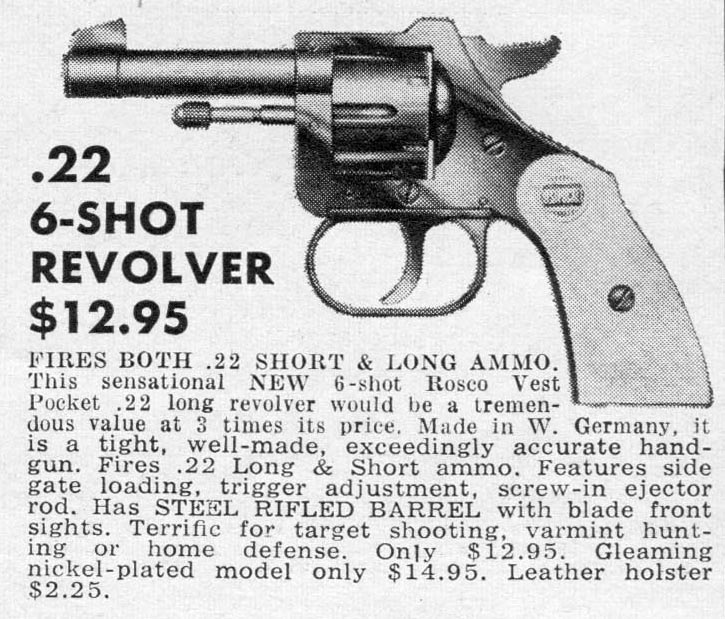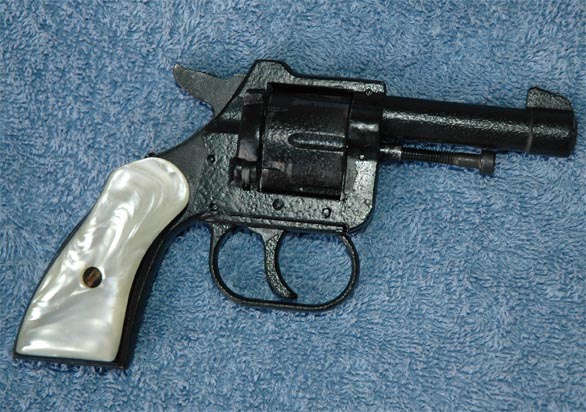THE WORST GUN I EVER OWNED

In 40+ years of gun ownership and collecting (perhaps “accumulating” is a better word) I have owned a fair number of bad guns. I’ve had three Llama pistols, every one of which was a dog, and every one of which was sold without regrets, but even a Llama isn’t complete junk. I’ve had two Jennings J-22’s, and though these are often derided as junk, in fact they’re impressive examples of how good a cheap product can be. In terms of being honest-to-God junk, the classic, all-time junker, by far the worst gun I own, has to be the little RG-10 revolver that lived in my salt-water tackle box.
The RG-10 is what most people would call a “Saturday Night Special,” a term concocted by anti-gunners many years ago, that has passed into common use. Wikipedia says this about the term:
The phrase Saturday Night Special is pejorative…for any inexpensive handgun. Saturday Night Specials have been defined as compact, inexpensive handguns with low perceived quality; however, there is no official definition of "Saturday night special" under federal law, though some states define "Saturday Night Special" or "Junk Guns" by means of composition or materials strength...The term…is often used disparagingly to emphasize the perceived lesser quality of the gun or, for political reasons relating to gun politics, to imply easy availability…to [imply]… that the only reason for the manufacture of such a gun is for use in crime…Despite the inexpensive manufacture…they are… not dangerous to the shooter when used correctly….Some "Saturday Night Specials" do, however, have reliability issues.
The RG-10 is one of several similar cheapies manufactured by Rohm
GMBH, a German  company. Before the cursed year of 1968, Rohm was the veritable
Mother Lode of Saturday Night Specials, which were imported into the USA by the
shipload. In those long-lost years of innocence, the RG-10 was sold under various brand names and different labels, including the one used in this ad from the July 1960 issue of Guns & Ammo, "The Rosco." For the record, I have never so much as laid eyes on a "gleaming nickel-plated" RG-10: every one I've ever seen has a "finish" of cheap black paint.
company. Before the cursed year of 1968, Rohm was the veritable
Mother Lode of Saturday Night Specials, which were imported into the USA by the
shipload. In those long-lost years of innocence, the RG-10 was sold under various brand names and different labels, including the one used in this ad from the July 1960 issue of Guns & Ammo, "The Rosco." For the record, I have never so much as laid eyes on a "gleaming nickel-plated" RG-10: every one I've ever seen has a "finish" of cheap black paint.
The frame is made of ZAMAK, an alloy of zinc, copper, aluminum, and magnesium developed in Germany many years ago. Guns made of ZAMAK are strong enough for low-powered rounds, and the RG-10 shoots about the lowest power round there is: the .22 Short. The barrel and cylinder are allegedly made of steel, but the front sight isn't. It's a slip-fit onto the end of the barrel and is literally glued in place. Nor did Rohm waste money on engineering frills like screws when they didn't have to. The RG-10 is held together by pins. The ejector rod is just that, a rod with an acorn-shaped head that screws into the axis pin. To eject empties from this gate-loaded gun you simply unscrew the rod and punch them out with it.
Nevertheless, as a kid I badly wanted a Rosco, don't ask me why. I suppose because I could (in theory) have afforded it, and in those easy times Seaport Traders would have sent me one without even asking my age (at the time, 13) let alone whether I had the requisite NY State pistol permit. Only the fact that my father has the same first name, and routinely opened all my mail, kept me from placing an order: I'd have been hard put to explain a box containing a revolver. So when one showed up on Auction Arms at a price that, if you factored in inflation, was about the same as $13 was in 1960, I bought it.
The gun I received was in decent shape, all things considered: that so many RG-10's are still floating around is perhaps testimony to the notion that they're better than they look, or that they don't get used much...or both. It was missing the ejector rod, but a trip to the local hardware store and a 25-cent cap screw fixed that. It had Pimp-Grade Imitation Pearl grips (by Jay Scott, and I'll bet those grips originally cost more than the gun did) for a touch of class. The paint was a little nicked here and there so I sprayed it with some matte black stove paint and a coat of clear lacquer, to tart it up a bit. Into the tackle box it went. I did shoot it now and then, and I'm sure that had I actually been standing inside a boxcar, I'd have hit the wall of it most of the time. The line about "tight, well-made, and exceedingly accurate" wasn't fooling anyone even 48 years ago, let alone now.
A week or two later I pulled out the tackle box and found that, despite being in a plastic bag and having a coat of paint, the little gun had developed a case of the Rusties. Moreover, it seemed to have some end play in the cylinder. So a little basement gunsmith work seemed in order.
 It really is simply amazing what can be done with an aluminum beer can and some Gorilla Glue. To shove the cylinder backwards a bit and eliminate the end play, I cut a strip from the can and glued it to the front frame riser. That also improved ignition—Wikipedia wasn't kidding about "reliability issues"—and tightened up the action overall. A little steel wool and lo, the rust was pretty much gone. That of course required a refinish, and I wanted something a bit tougher than paint. That meant only one thing: truck bed liner spray.
It really is simply amazing what can be done with an aluminum beer can and some Gorilla Glue. To shove the cylinder backwards a bit and eliminate the end play, I cut a strip from the can and glued it to the front frame riser. That also improved ignition—Wikipedia wasn't kidding about "reliability issues"—and tightened up the action overall. A little steel wool and lo, the rust was pretty much gone. That of course required a refinish, and I wanted something a bit tougher than paint. That meant only one thing: truck bed liner spray.
Bed liner spray is great stuff. Very tough, dead black, and thick enough to help tighten the gun up even more. Better yet, some of the cross pins had a tendency to fall out, and the trigger pivot tended to unseat itself, but an overlay of bed liner spray fixed that in a hurry.
After all this rehabilitation, I needed to take the RG-10 out and use it, so last Saturday on Opening Day of squirrel season it came with me, and was actually used to deliver a coup de grace.
Cheap guns do have their place in the firearms food chain. People who can’t afford anything better have a need for protection, too; and there are places where no one in his sense would put a good gun: a tackle box used for salt water fishing is one of them. I bought this POS specifically for the latter reason. If it rusted to pieces or fell over the side of my boat in the coastal waters of North Carolina, well, I’d not have wept too much. A tackle box gun is used when you catch a fish so big that you don’t want it in the boat with you: you just shoot it in the head and tow it home. My RG-10 went back with me to Oak Island in the Summer.
| HUNTING | GUNS | DOGS |
| FISHING & BOATING | TRIP REPORTS | MISCELLANEOUS ESSAYS |
| CONTRIBUTIONS FROM OTHER WRITERS|
| RECIPES |POLITICS |